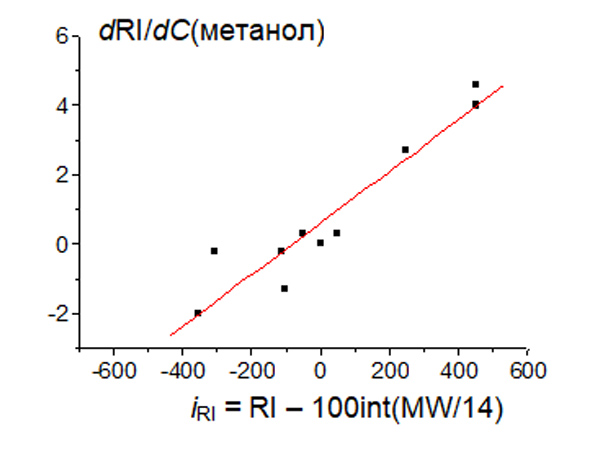
АНАЛИТИЧЕСКИЕ АСПЕКТЫ ЗАВИСИМОСТИ ИНДЕКСОВ УДЕРЖИВАНИЯ ОРГАНИЧЕСКИХ СОЕДИНЕНИЙ В ОБРАЩЕННО-ФАЗОВОЙ ВЭЖХ ОТ СОДЕРЖАНИЯ МЕТАНОЛА В СОСТАВЕ ЭЛЮЕНТА
Аннотация
В результате определения индексов удерживания (RI) 11 органических соединений различной полярности в обращенно-фазовой (ОФ) ВЭЖХ при использовании метанола в составе элюента (С) вычислены коэффициенты зависимости RI(С), т.е. dRI/dС. Формально такие параметры эквивалентны температурным коэффициентам газохроматографических индексов удерживания, b = dRI/dT. Показано, что эти коэффициенты варьируют в широких пределах (в настоящей работе от -2.0 до +4.6), что указывает на необходимость выявления факторов, определяющих их знак и величину. Установлено, что корреляция величин dRI/dС с самими индексами удерживания и со значениями факторов гидрофобности log P (логарифмы коэффициентов распределения в гетерофазной системе 1-октанол/вода), практически отсутствует. Лучше всего коэффициенты dRI/dС коррелируют с такими характеристиками полярности органических соединений, как гомологические инкременты факторов гидрофобности (ilogP) и гомологические инкременты индексов удерживания (iRI). Такие преобразования значений различных свойств А как гомологические инкременты характеризуют разные гомологи вне зависимости от их положения в гомологических рядах, так что величины ilogP и iRI являются характеристиками полярности соответствующих рядов. Подобный подход позволил установить, что зависимость индексов удерживания в ОФ ВЭЖХ от содержания метанола в составе элюента определяется именно полярностью аналитов и их гидрофобно-гидрофильными характеристиками. Для неполярных аналитов типично соотношение dRI/dC > 0, тогда как для полярных – dRI/dC < 0. Следовательно, определение даже знака этого коэффициента обеспечивает важную информацию о природе аналитов.
Ключевые слова: Обращенно-фазовая высокоэффективная жидкостная хроматография, элюент метанол-вода, неполярные и полярные аналиты, индексы удерживания, зависимость индексов от состава элюента
Полный текст:
PDF (Russian)Литература
REFERENCES
Kovats Retention Index System. In Encyclopedia of Chromatography. Ed. J. Cazes. 3rd Edn. Boca Raton, CRC Press (Taylor & Francis Group), 2010, pp. 1304-1310.
The NIST Mass Spectral Library (NIST/EPA/NIH EI MS Library, 2020 Release). Software/Data Ver¬si¬on; NIST Standard Reference Database, Number 69, May 2020. National Insti¬tute of Standards and Techno¬logy, Gaithersburg, MD 20899: http://webbook.nist.gov (Accessed: November 2021).
Golovnya R.V., Arsen`ev Yu.N. [System of retention indices and its physicochemical application]. Uspekhi Khimii [Russ. Chem. Rev.], 1973, vol. 42, no. 12, pp. 1034-1059. doi: 10.1070/RC1973v042n12ABEH002783.
Mitra G.D., Saha N.C. Theory of the linearity of retention index with column temperature. Its versatility and importance in gas chromatography. Chromatographia, 1973, vol. 6, pp. 93-103.
Bangjie C., Shaoyi P. The temperature dependence of retention indices in gas chromatography. Chromatographia, 1988, vol. 25, pp. 731-734.
Boneva S., Dimov N. Unified retention indices of hydrocarbons separated on dimethylsilicone OV-101. Chromatographia, 1986, vol. 21, pp. 697-700.
Skrbic B.D. Unified retention concept – statistical treatment of Kovats retention index. J. Chromatogr. A, 1977, vol. 764, pp. 257-264. doi: 10.1016/s0021-9673(96)00955-7.
Smith R.M. Alkyl aryl ketones as a reference index scale in liquid chromatography. J. Chromatogr. A, 1982, vol. 236, pp. 313-320. doi: 10.1016/S0021-9673(00)84880-3.
Smith R.M., Finn N. Comparison of retention index scales based on alkyl aryl ketones, alkan-2-ones and 1-nitroalkanes for polar drugs on reversed-phase HPLC. J. Chromatogr. A, 1991, vol. 537, pp. 51-60. doi: 10.1016/S0021-9673(01)88885-3.
Smith R.M. Retention indices scales used in HPLC. In Retention and Selectivity in Liquid Chromatography. Ed. R.M. Smith. Ser. J. Chromatogr. Library, 1995, vol. 57, pp. 93-144. doi: 10.1016/S0301-4770(08)60615-6.
Zenkevich I.G., Kochetova M.V., Larionov O.G., Revina A.A., Kosman V.M. Retention indices as the most reproducible retention parameters in reversed phase HPLC. Calculation for hydrophilic phenolic compounds using reference n-alkyl phenyl ketones. J. Liquid Chromatogr. & Related Technol., 2005, vol. 28, pp. 2141-2162. doi: 10.108/JLC-200064000.
Smith R.M. Retention indices in reversed-phase HPLC. Advanced in chromatography. J.C. Giddings, E. Grushka (Eds.). Boca-Raton: CRC Press, 2021, pp. 277-319. doi: 10.1201/9781003209027.
Zenkevich I.G., Nikitina D.A., Derouiche A. Formation and chromatographic detection of organic compounds hydrates. J. Analyt. Chem. (Rus.), 2021, vol. 76, no. 4, pp. 493-502. doi: 10.1134/S1061934821040146.
Kornilova T.A., Derouiche A., Zenkevich I.G. [Recurrent approximation of retention parameters as confirmation of N-substituted sulfonamides hydrate formation in reversed phase HPLC]. Analitika i Kontrol’ [Analytics and Control], 2020, vol. 24, no. 4, pp. 315-322. doi: 10.15826/analitika.2020.24.4.006. (In Russian).
Zenkevich I.G., Nikitina D.A., Kornilova T.A. Recurrent approximation of retention parameters of N-substituted p-toluenesulfonamides in reversed-phase high performance liquid chromatography for revealing the formation of their hydrates. Rus. J. Phys. Chem. A, 2021, vol. 95, no. 9, pp. 1923-1933. doi: 10.1134/S0036024421090326.
Zenkevich I.G., Derouiche A., Nikitina D.A. Detection of organic hydrates in reversed phase high performance liquid chromatography using recurrent approximation of their retention times. J. Liquid Chromatogr. Related Technol., 2021, vol. 00, no. 00. pp. 000-000. doi: 10.1080/10826076.2021.1998905.
Peterson M.L., Hirsch J. A calculation for locating the carrier gas front of a gas-liquid chromatogram. J. Lipid Res., 1959, vol. 1, pp. 132-134.
Hanai T. Structure-retention correlation in liquid chromatography. J. Chromatogr. A, 1991, vol. 550, pp. 313-324. doi: 10.1016/S0021-9673(01)88547-2.
Lochmuller C.H., Hui M. Calculated logkOW as a guide for key set mobile phase selection in retention prediction. J. Chromatogr. Sci., 1998, vol. 36, pp. 11-18.
Hanai T., Koizumi K., Kinoshita T. Prediction of retention factors of phenolic and nitrogen containing compounds in reversed-phase liquid chromatography based on logP and pKa obtained by computational chemical calculation. J. Liquid Chromatogr. & Related Technol., 2000, vol. 23, pp. 363-385. doi: 10.1081/JLC-100101457.
Glaginis C., Tsantili-Kakoulidou A. Current state of the art in HPLC methodology for lipophilicity assessment of basic drugs. A review. J. Liquid Chroma¬togr. & Rela¬ted Technol., 2008, vol. 31, pp. 79-96. doi: 10.1080/10826070701665626.
Liang C., Qiao J.-G., Lian H.-Z. Determination of reversed-phase HPLC based octanol-water partition coefficient for neutral and ionizable compounds: methodogy evaluation. J. Chromatogr. A, 2017, vol. 1528, pp. 25-34. doi: 10.1016/j.chroma.2017.10.064.
Zenkevich I.G., Ioffe B.V. Interpretation of mass spectra of organic compounds [Interpretatsia mass spektrov organicheskikh soedinenii]. Leningrad, Khimia Publ, 1986, 176 p. (In Russian).
Zenkevich I.G. Homologous increments of gas chromatographic retention indices as characteristic of organic substances polarity. Rus. J. General Chem., 2019, vol. 89, no. 3, pp. 369-377. doi: 10.1134/S1070363219030010.
DOI: https://doi.org/10.15826/analitika.2022.26.1.004
Ссылки
- На текущий момент ссылки отсутствуют.
